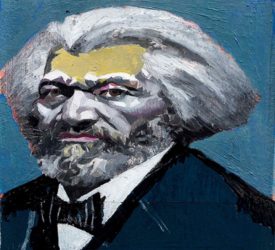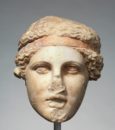 Featured – Frederick Douglass: Prophet of Freedom by David Blight. Blight, who teaches American history at Yale, has long been drawn to the study of Douglass: His first book, published 30 years ago, examined Douglass’s career during the Civil War. Blight has been able to delve more deeply than previous scholars into a period that many have depicted as an anticlimax, when the fiery moral crusader became a Republican Party functionary and government bureaucrat. Overall, the result is a consistently engrossing book that is likely to remain the definitive account of Douglass’s life for many years to come. Eric Foner / The Nation Read more
Featured – Frederick Douglass: Prophet of Freedom by David Blight. Blight, who teaches American history at Yale, has long been drawn to the study of Douglass: His first book, published 30 years ago, examined Douglass’s career during the Civil War. Blight has been able to delve more deeply than previous scholars into a period that many have depicted as an anticlimax, when the fiery moral crusader became a Republican Party functionary and government bureaucrat. Overall, the result is a consistently engrossing book that is likely to remain the definitive account of Douglass’s life for many years to come. Eric Foner / The Nation Read more
 Trump’s Midterms Strategy Is Fear, Lies, and (White) Nationalism. Given Trump’s inflammatory, nonstop racism, we know when he talks about nationalism he means white nationalism. White nationalists applauded Trump’s rhetorical turn, according to the folks at Right Wing Watch. Gab, the social media site that hosts white supremacists who are too toxic for Twitter, called Trump “stunning and brave” to “come out of the closet as an American Nationalist.” Joan Walch / The Nation Read more
Trump’s Midterms Strategy Is Fear, Lies, and (White) Nationalism. Given Trump’s inflammatory, nonstop racism, we know when he talks about nationalism he means white nationalism. White nationalists applauded Trump’s rhetorical turn, according to the folks at Right Wing Watch. Gab, the social media site that hosts white supremacists who are too toxic for Twitter, called Trump “stunning and brave” to “come out of the closet as an American Nationalist.” Joan Walch / The Nation Read more
 America’s Relentless Suppression of Black Voters. Republican attempts to exclude African Americans from the polls echoes efforts by Southern whites that enabled Jim Crow era. Lawrence Goldstone / The New Republic Read more
America’s Relentless Suppression of Black Voters. Republican attempts to exclude African Americans from the polls echoes efforts by Southern whites that enabled Jim Crow era. Lawrence Goldstone / The New Republic Read more
 Booked: How to Pick an Electorate, with Carol Anderson. In her new book One Person, No Vote: How Voter Suppression Is Destroying Our Democracy, distinguished historian and educator Carol Anderson makes it clear: There is an insidious, well-organized movement actively working to disenfranchise people of color. She discusses how progressives can overcome voter suppression heading into the midterms and beyond. Marcia Chatelain / Dissent Read more
Booked: How to Pick an Electorate, with Carol Anderson. In her new book One Person, No Vote: How Voter Suppression Is Destroying Our Democracy, distinguished historian and educator Carol Anderson makes it clear: There is an insidious, well-organized movement actively working to disenfranchise people of color. She discusses how progressives can overcome voter suppression heading into the midterms and beyond. Marcia Chatelain / Dissent Read more
 Stacey Abrams and the Politics of Georgia’s Old State Flag. On Monday, photographs surfaced showing Stacey Abrams, the Democratic nominee, participating in the burning of a Georgia state flag, in 1992, when she was a sophomore at Spelman College, in Atlanta. At the time, the flag was a source of great controversy in the state, because it incorporated the Stars and Bars of the Confederate flag. Jelani Cobb / The New Yorker Read more
Stacey Abrams and the Politics of Georgia’s Old State Flag. On Monday, photographs surfaced showing Stacey Abrams, the Democratic nominee, participating in the burning of a Georgia state flag, in 1992, when she was a sophomore at Spelman College, in Atlanta. At the time, the flag was a source of great controversy in the state, because it incorporated the Stars and Bars of the Confederate flag. Jelani Cobb / The New Yorker Read more
 Confederate pride and prejudice. Some white Northerners see a flag rooted in racism as a symbol of patriotism. A short walk from where President-elect Abraham Lincoln made the last train stop in his home state before leaving for Washington on the verge of the Civil War, a Confederate battle flag flies from a home garage. Frances Stead Sellers / Wash Post Read more
Confederate pride and prejudice. Some white Northerners see a flag rooted in racism as a symbol of patriotism. A short walk from where President-elect Abraham Lincoln made the last train stop in his home state before leaving for Washington on the verge of the Civil War, a Confederate battle flag flies from a home garage. Frances Stead Sellers / Wash Post Read more
 At trial, Harvard officials explain rejecting alternatives to using race in admissions. Two Harvard faculty members who served in top roles at the school testified Tuesday that they thoroughly reviewed alternatives to considering race in Harvard’s undergraduate admissions process, but concluded that other measures would fail to maintain racial diversity or would have unacceptable impacts on the overall quality of students entering the elite university. Josh Gerstein / Politico Read more
At trial, Harvard officials explain rejecting alternatives to using race in admissions. Two Harvard faculty members who served in top roles at the school testified Tuesday that they thoroughly reviewed alternatives to considering race in Harvard’s undergraduate admissions process, but concluded that other measures would fail to maintain racial diversity or would have unacceptable impacts on the overall quality of students entering the elite university. Josh Gerstein / Politico Read more
 Can these descendants of enslaved Africans save their unique culture. I first heard of the Gullah Geechee when my family moved to South Carolina more than 40 years ago. I remember hearing there were African Americans living nearby who spoke a distinct Creole English. Many years later, while living on Hilton Head Island, I began to document their culture after becoming aware of how rampant development and gentrification was threatening their land and way of life. Pete Marovich / Wash Post Read more
Can these descendants of enslaved Africans save their unique culture. I first heard of the Gullah Geechee when my family moved to South Carolina more than 40 years ago. I remember hearing there were African Americans living nearby who spoke a distinct Creole English. Many years later, while living on Hilton Head Island, I began to document their culture after becoming aware of how rampant development and gentrification was threatening their land and way of life. Pete Marovich / Wash Post Read more
 Le’Veon Bell’s agent knows the struggle. Adisa Bakari teaches his NFL clients to ‘understand your worth. Bakari represents Le’Veon Bell, the 26-year-old Pittsburgh Steelers running back whose contract dispute is challenging the balance of power between athletes and team owners. Jesse Washington / The Undefeated Read more
Le’Veon Bell’s agent knows the struggle. Adisa Bakari teaches his NFL clients to ‘understand your worth. Bakari represents Le’Veon Bell, the 26-year-old Pittsburgh Steelers running back whose contract dispute is challenging the balance of power between athletes and team owners. Jesse Washington / The Undefeated Read more
 The Myth of Whiteness in Classical Sculpture. Greek and Roman statues were often painted, but assumptions about race and aesthetics have suppressed this truth. Now scholars are making a color correction. Margaret Talbot / The New Yorker Read more
The Myth of Whiteness in Classical Sculpture. Greek and Roman statues were often painted, but assumptions about race and aesthetics have suppressed this truth. Now scholars are making a color correction. Margaret Talbot / The New Yorker Read more
Visit our home page for more articles. And at the top of this page register your email to receive notification of new editions of Race Inquiry Digest. Click here for earlier Digests.